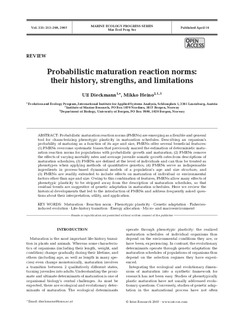| dc.description.abstract | Probabilistic maturation reaction norms (PMRNs) are emerging as a flexible and general tool for characterizing phenotypic plasticity in maturation schedules. Describing an organism’s probability of maturing as a function of its age and size, PMRNs offer several beneficial features: (1) PMRNs overcome systematic biases that previously marred the estimation of deterministic maturation reaction norms for populations with probabilistic growth and maturation; (2) PMRNs remove the effects of varying mortality rates and average juvenile somatic growth rates from descriptions of maturation schedules; (3) PMRNs are defined at the level of individuals and can thus be treated as phenotypes when applying methods of quantitative genetics; (4) PMRNs serve as indispensable ingredients in process-based dynamical models of a population’s age and size structure; and (5) PMRNs are readily extended to include effects on maturation of individual or environmental factors other than age and size. Owing to this combination of features, PMRNs allow many effects of phenotypic plasticity to be stripped away from the description of maturation schedules, so that residual trends are suggestive of genetic adaptation in maturation schedules. Here we review the historical developments that led to the introduction of PMRNs and address frequently asked questions about their interpretation, utility, and application. | |
